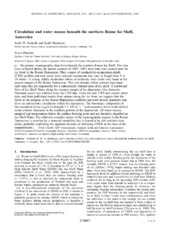Circulation and water masses beneath the northern Ronne Ice Shelf, Antarctica
Journal article
Permanent lenke
https://hdl.handle.net/1956/597Utgivelsesdato
2004-12-14Metadata
Vis full innførselSamlinger
- Geophysical Institute [1195]
Originalversjon
https://doi.org/10.1029/2004jc002302Sammendrag
We present oceanographic data from beneath the northern Ronne Ice Shelf. The data were collected during the austral summer of 2002–2003 from four sites located near the ice front in the Ronne Depression. They consist of conductivity-temperature-depth (CTD) profiles and time series from moored instruments that vary in length from 9 to 20 weeks. A strong, tidally modulated inflow of relatively fresh water was found at the eastern margin of the Ronne Depression. This low-density inflow powers high basal melt rates that are responsible for a substantially thinned area of ice shelf. A northward flow of Ice Shelf Water along the western margin of the depression (the Antarctic Peninsula coast) was inferred from the CTD data. From the new CTD and current meter data, and from published results from cruises along the ice front, we suggest that the flows at the margins of the Ronne Depression establish east-west density gradients that drive an anticyclonic circulation within the depression. The barotropic component of the circulation forms a gyre of strength 5 × 105 m3 s−1 and occupies a bowl in the field of water column thickness in the northern portion of the depression. All water masses sampled had temperatures below the surface freezing point and are therefore classified as Ice Shelf Water. The relatively complex nature of the oceanographic regime in the Ronne Depression is overlain by a seasonal variability that is hinted at by the available time series, probably explaining the apparent absence of inflowing HSSW at the time of the measurements.
